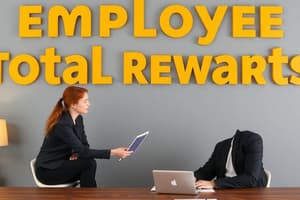Podcast
Questions and Answers
Short-term employee benefits must be settled wholly after 12 months from the end of the annual reporting period.
Short-term employee benefits must be settled wholly after 12 months from the end of the annual reporting period.
False (B)
Post-employment benefits include pension and life insurance as part of employee compensation.
Post-employment benefits include pension and life insurance as part of employee compensation.
True (A)
Termination benefits are recognized as an expense during the reporting period in which the employee renders service.
Termination benefits are recognized as an expense during the reporting period in which the employee renders service.
False (B)
Accrued liabilities for short-term employee benefits are recorded at discounted amounts.
Accrued liabilities for short-term employee benefits are recorded at discounted amounts.
Accumulating paid sick leave is considered a short-term compensated absence if it is expected to occur within 12 months.
Accumulating paid sick leave is considered a short-term compensated absence if it is expected to occur within 12 months.
In a Non-Contributory Plan, the employer is obligated to make contributions to the retirement fund.
In a Non-Contributory Plan, the employer is obligated to make contributions to the retirement fund.
Other long-term employee benefits include benefits such as sabbaticals and jubilee payments.
Other long-term employee benefits include benefits such as sabbaticals and jubilee payments.
Non-monetary benefits like bonuses are considered short-term employee benefits.
Non-monetary benefits like bonuses are considered short-term employee benefits.
Funded Plans require that a trustee administers the resources and pays out employee benefits.
Funded Plans require that a trustee administers the resources and pays out employee benefits.
Both actuarial and investment risks fall on the employer in a Defined Contribution Plan.
Both actuarial and investment risks fall on the employer in a Defined Contribution Plan.
A Defined Benefit Plan guarantees benefits based on factors such as age and length of service.
A Defined Benefit Plan guarantees benefits based on factors such as age and length of service.
Contributory Plans only require financial commitments from the employees without employer contributions.
Contributory Plans only require financial commitments from the employees without employer contributions.
Vesting allows an employee to receive unused leave only at the date they leave the entity.
Vesting allows an employee to receive unused leave only at the date they leave the entity.
Non-vesting compensated absences allow employees to claim unused benefits at any time.
Non-vesting compensated absences allow employees to claim unused benefits at any time.
The expected cost for future compensated absences is recognized as an expense when benefits are used.
The expected cost for future compensated absences is recognized as an expense when benefits are used.
Liabilities for vested benefits are determined at year-end based on the best estimate of unclaimed benefits.
Liabilities for vested benefits are determined at year-end based on the best estimate of unclaimed benefits.
Non-accumulating compensated absences require accrual at year-end.
Non-accumulating compensated absences require accrual at year-end.
LIFO is a method used to measure the amount of obligation for non-vesting benefits.
LIFO is a method used to measure the amount of obligation for non-vesting benefits.
For accumulating compensated absences, the liability increases with the amount unclaimed at year-end.
For accumulating compensated absences, the liability increases with the amount unclaimed at year-end.
The measurement of non-vesting benefits is based on a different standard than that of accumulating benefits.
The measurement of non-vesting benefits is based on a different standard than that of accumulating benefits.
Entities are required to expensed all costs of non-accumulating compensated absences when they occur.
Entities are required to expensed all costs of non-accumulating compensated absences when they occur.
Accumulating compensated absences are recognized as an expense only at retirement.
Accumulating compensated absences are recognized as an expense only at retirement.
Flashcards
Employee Benefits
Employee Benefits
Any consideration given by an employer in exchange for employee services, including termination of employment.
Short-Term Employee Benefits
Short-Term Employee Benefits
Benefits expected to be settled within 12 months after the end of the reporting period, excluding termination benefits.
IAS 19
IAS 19
The International Accounting Standard that outlines the accounting treatment for employee benefits.
Post-Employment Benefits
Post-Employment Benefits
Signup and view all the flashcards
Termination Benefits
Termination Benefits
Signup and view all the flashcards
Accrual of Wages and Salaries
Accrual of Wages and Salaries
Signup and view all the flashcards
Short-Term Compensated Absences
Short-Term Compensated Absences
Signup and view all the flashcards
Accumulating Compensated Absences
Accumulating Compensated Absences
Signup and view all the flashcards
Vesting
Vesting
Signup and view all the flashcards
Non-Vesting
Non-Vesting
Signup and view all the flashcards
How are accumulated compensated absences measured?
How are accumulated compensated absences measured?
Signup and view all the flashcards
LIFO Method
LIFO Method
Signup and view all the flashcards
Non-Accumulating Compensated Absences
Non-Accumulating Compensated Absences
Signup and view all the flashcards
Informal Benefit Plan
Informal Benefit Plan
Signup and view all the flashcards
Formal Benefit Plan
Formal Benefit Plan
Signup and view all the flashcards
Contributory Plan
Contributory Plan
Signup and view all the flashcards
Non-Contributory Plan
Non-Contributory Plan
Signup and view all the flashcards
Funded Plan
Funded Plan
Signup and view all the flashcards
Unfunded Plan
Unfunded Plan
Signup and view all the flashcards
Defined Contribution Plan
Defined Contribution Plan
Signup and view all the flashcards
Study Notes
Employee Benefits
- Employee benefits are all forms of consideration given by an entity in exchange for service rendered by employees or for termination of employment.
IAS 19
-
Short-term employee benefits (other than termination benefits): Expected to be settled within 12 months after the end of the reporting period. This includes wages, salaries, SSS contributions, bonuses, and non-monetary benefits.
-
Post-employment benefits: Benefits payable after employment completion. This includes pension, lump sum payments on retirement, post-employment life insurance, and medical care.
-
Other long-term employee benefits: Benefits other than termination, short-term, and termination benefits. It includes long service leave, sabbatical, jubilee/long service benefits, and long-term stability benefits.
-
Termination benefits: Benefits given in exchange for the termination of an employee's employment due to the entity's decision to terminate the employee.
Short-Term Employee Benefits - Recognition and Measurement
- Expenses are recognized during the reporting period when the employee rendered service, unless the service cost results in other assets (like property, plant, equipment, or inventory).
- At the end of the reporting period, any unpaid amounts are recognized as a liability at their undiscounted amount.
- Accrual of wages and salaries: Compensation expense or equivalent account, and Accrued liability.
- Short-term compensated absences: Annual leave and paid sick leave are expected to occur in the next 12 months, either accumulating or non-accumulating.
Accumulating Short-Term Employee Benefits
-
Accumulating Compensated Absences: Carried forward and can be used in a future period if the current period's entitlement is not used in full.
-
Vesting: Employees are entitled to receive the date they leave the entity, typically unused leave accumulated and paid at retirement.
-
Non-vesting: Not entitled to payment for unused leave; usually recorded as an expense when the absence occurs and increases future compensated absences.
-
Measurement: Liability at year-end (best estimate). For vesting, liability increases upon leaving; measured at year-end and remeasured at the expected rate. For non-vesting, only measured at year-end, within available periods. LIFO method calculates expense, treating excess of annual entitlement as a liability.
Non-Accumulating Short-Term Employee Benefits
- Non-accumulating Compensated Absences: are not carried forward and do not require accrual at year-end. The cost is recognized when the absence occurs; it's expensed unless another standard dictates it should be recognized as a cost of another asset.
Post-employment Benefits
- Benefits payable after employment completion (other than termination and short-term benefits).
- Formal and Informal benefit plans (for 1 or more employees).
- Includes retirement benefits (pension), and post-employment benefits (life insurance, medical care).
- Retirement benefit plans (contributory, non-contributory, funded, unfunded, defined contribution, defined benefit plans).
Contributory vs. Non-Contributory Plans
- Contributory Plans: Both employers and employees contribute to the fund.
- Non-Contributory Plans: Only the employer contributes to the fund and bears the cost of benefits.
Funded vs. Unfunded Plans
- Funded Plans: A trustee administers the resources.
- Unfunded Plans: The employer retains the right to manage the fund and bears the obligation to settle benefits. No trustee exists for the fund.
Studying That Suits You
Use AI to generate personalized quizzes and flashcards to suit your learning preferences.
Related Documents
Description
This quiz covers the different types of employee benefits as defined under IAS 19. You will learn about short-term, post-employment, long-term, and termination benefits. Test your knowledge on how these benefits impact both employees and employers.




